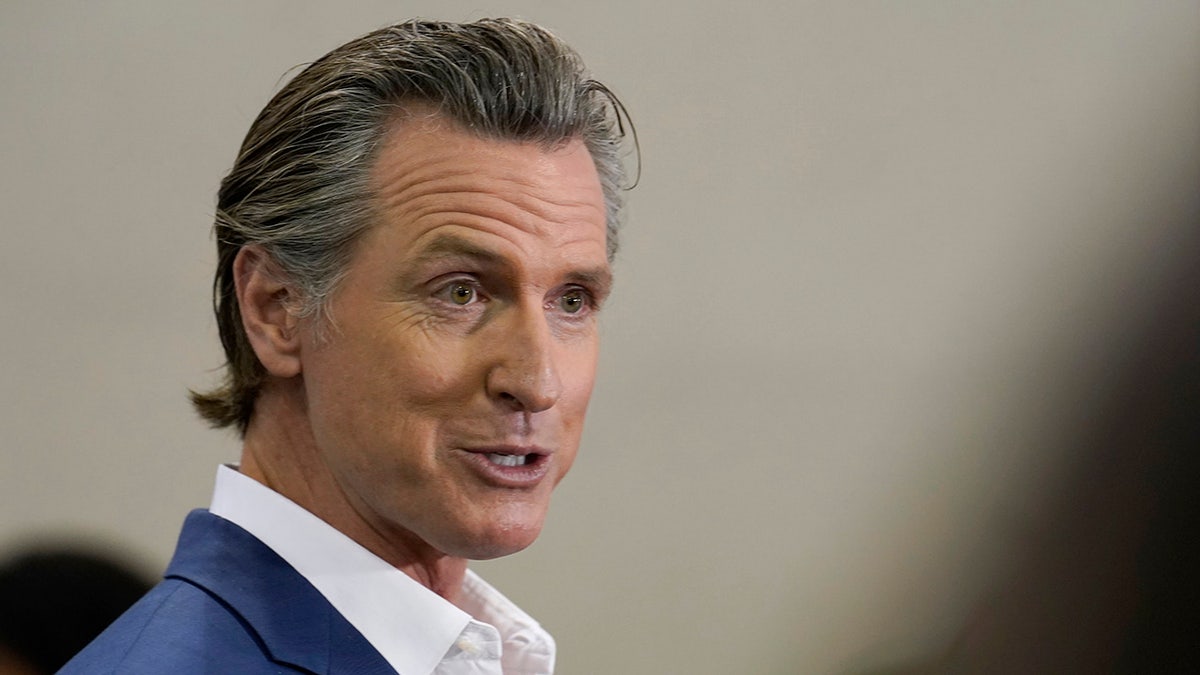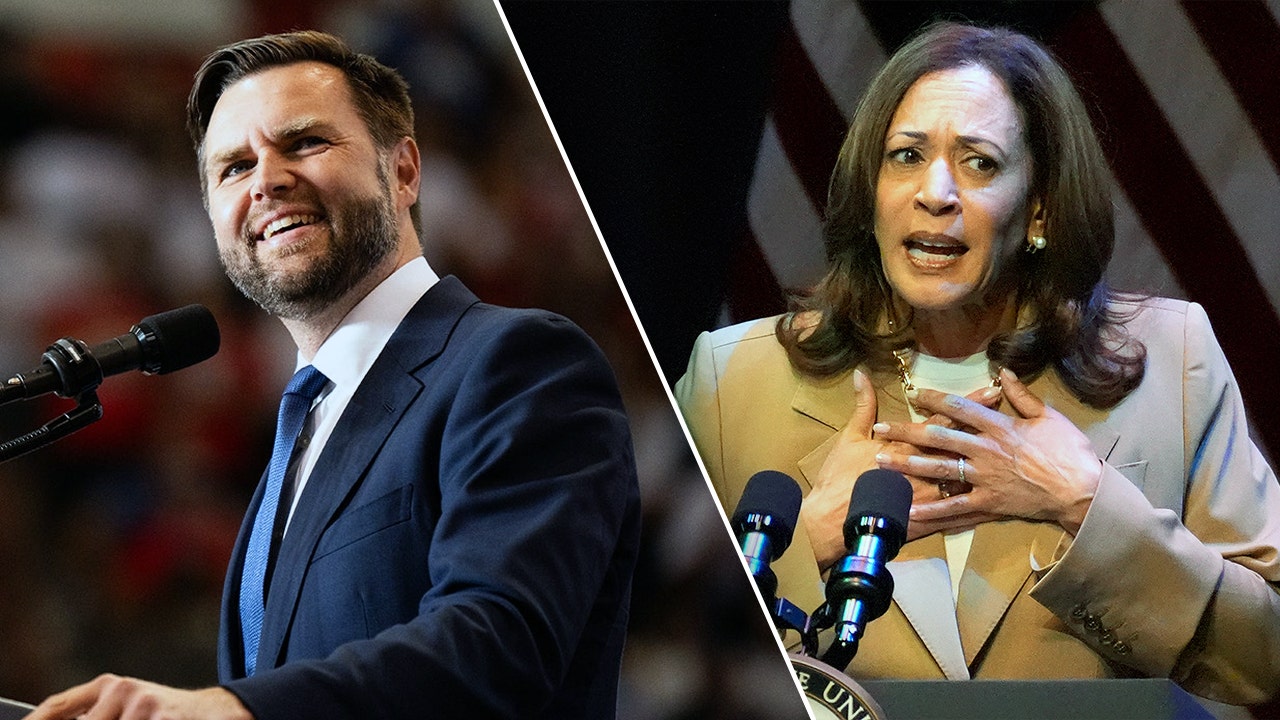In the weeks before former president Donald Trump announced his vice-presidential pick, some of tech’s biggest names launched a quiet campaign to push for one of their own: Ohio Sen. JD Vance.
West
Newsom urges Oakland officials to tighten 'extreme' policy that restricts police chases

California Gov. Gavin Newsom, a Democrat, called on Oakland officials Friday to amend an “extreme” policy that generally only allows police to chase suspected criminals in cases of “violent forcible crimes.”
The governor sent a letter to Oakland Mayor Sheng Thao, the Oakland City Council and the Oakland Police Commission urging them to reconsider the Oakland Police Department (OPD) policy that limits officers’ ability to pursue suspects.
“Although some California jurisdictions allow vehicle pursuits for only certain crimes (e.g., felonies), Oakland is an outlier by imposing exceptional restrictions on OPD’s ability to police criminal activity, generally permitting pursuits only for ‘violent forcible crimes,’ as defined in OPD’s policy, and crimes involving firearms,” Newsom wrote.
The letter said that, unlike most other jurisdictions in the state, local police in Oakland are prohibited from pursuing people suspected of committing various felonies and any misdemeanor, including those that are violent, as well as other offenses that endanger public safety, such as reckless driving, sideshow activity and driving under the influence of drugs or alcohol.
GOV NEWSOM ORDERS HOMELESS ENCAMPMENTS TORN DOWN ACROSS CALIFORNIA: ‘NO MORE EXCUSES’
California Gov. Gavin Newsom speaks in Sacramento, California, Jan. 10, 2023. (AP Photo/José Luis Villegas, File)
“I am mindful of the sensitivities around vehicle pursuits, which can be dangerous to police, suspects, and innocent bystanders,” the governor wrote. “California’s Commission on Peace Officer Standards and Training recognizes and addresses this in its standard-setting guidance. But there is also extreme danger to the public in allowing criminals to act with impunity, and the reckless driving associated with sideshows and other criminal acts is a significant threat to public safety — as witnessed regularly by the public in viral videos and news coverage.”
This comes after Newsom’s recent move to increase California Highway Patrol (CHP) in Oakland to conduct surge operations targeting organized crime, sideshows, carjackings and other criminal activity.
Newsom said the move quickly produced several arrests of suspects accused of committing these crimes. Two days after the governor’s announcement, the CHP used ground and airborne assets to conduct a surge operation targeting sideshows. Several vehicle pursuits through that operation led to five felony arrests, eight DUIs, the recovery of eight stolen vehicles and the seizure of two guns.
“In the course of the CHP’s operations, however, they have observed, based on their professional law enforcement experience and expertise, certain dynamics that are contributing to Oakland’s public safety challenges,” Newsom wrote in the letter. “In particular, the CHP has brought to my attention that they observed criminals often fleeing with impunity because it’s common knowledge that the Oakland Police Department’s (‘OPD’) pursuit policy allows vehicle pursuits in only very limited circumstances.”
Newsom said CHP observed suspects attempting to avoid arrest by using the same routes, meaning that the suspects knew where OPD would stop chasing them. But, the governor said, the suspects were unable to avoid the six pursuits initiated by CHP, which had a number of resources available to them, including air support.
CA SCHOOL DISTRICT SUES NEWSOM OVER BILL BANNING SCHOOLS FROM NOTIFYING PARENTS OF CHILD’S GENDER IDENTITY

California Gov. Gavin Newsom speaks at a news conference in Sacramento, California, Thursday, March 16, 2023. (AP Photo/Rich Pedroncelli)
“Any policy on vehicle pursuits must be clear-eyed in balancing the risks and benefits involved,” Newsom’s letter read. “Because of Oakland’s public safety challenges and the degree to which OPD’s pursuit policy is an outlier among California law enforcement agencies, I support the recent action by the City Council to direct a review of this policy.
“I urge you to reconsider whether OPD should be permitted to pursue suspects in more circumstances to improve public safety in your city and to establish a process to evaluate whether OPD is making full use of its authority, including that granted under the existing pursuit policy, to protect public safety and enforce the law,” he continued.
Newsom concluded his letter by saying he is committed to improving public safety in Oakland and across California. He said there have been some recent improvements in public safety, but that officials “owe it to our communities to continue to search for solutions.”
Read the full article from Here

Washington
Inside the powerful Peter Thiel network that anointed JD Vance

Vance’s most forceful Silicon Valley advocates are euphoric about the former never Trumper’s rise in the GOP. They see Vance as their emissary in Washington, spreading a doctrine that government and entrenched corporate giants from Google to Lockheed Martin stifle innovation, while nimble, bold-thinking start-ups — especially their own — can propel the national interest. And while the ascendance of Vice President Harris has invigorated many left-leaning tech leaders, some in Thiel’s network would stand to benefit from having Vance in the White House — a new asset for venture capitalists who until recently shunned Washington.
“WE HAVE A FORMER TECH VC IN THE WHITE HOUSE GREATEST COUNTRY ON EARTH BABY,” Delian Asparouhov, a partner at Thiel’s Founder’s Fund, wrote on X after the announcement of Vance’s nomination.
For Thiel, Vance’s presence on the ticket is the payoff on a prescient bet placed a decade ago, when he embraced the Yale Law School graduate with Rust Belt roots as his protégé — joining a roster that included Meta CEO Mark Zuckerberg and OpenAI founder Sam Altman.
Especially after the publication in 2016 of his memoir “Hillbilly Elegy,” Vance impressed Thiel’s rarefied Silicon Valley set with what they saw as an omnivorous intellect, mild manner and outsider story of growing up working class in Ohio — a narrative that resonated after the 2016 election, as tech elites sought to understand how their obsession with building the future was leaving so many Americans behind.
Thiel made him wealthy, setting him up to invest in companies that became popular with the MAGA set. He shepherded Vance’s entry into politics, bankrolling, alongside other Silicon Valley donors, his successful bid for the U.S. Senate in 2022.
“For Peter,” said one of the people familiar with his thinking, “Vance is a generational bet.”
But Vance’s connections in the business world — along with his stances on social issues such as abortion and gay marriage — have also opened him up to criticism. Critics have called him a “shillbilly,” arguing that his relationship to the Thiel network could become a pay-to-play scenario.
“The best way for them to [instate] their elitist scheme and reactionary views is regulatory capture,” investor Del Johnson posted on X, using a term to describe the private sector’s control of the regulatory process. “You haven’t seen anything yet if you let the VC class get into the presidency.”
This report is based on 17 interviews with people familiar with Vance’s rise in the Valley, his relationship with Thiel, and the tech world’s ambitions for him should he win the country’s second highest political office, many of whom spoke on the condition of anonymity to protect their relationships.
Thiel declined to comment. Vance did not respond to comment requests.
Though Thiel became a Trump megadonor during the 2016 campaign, he ultimately was disappointed by the disorganization of his administration, as well as the lack of focus on science and innovation, according to several people with knowledge of his thinking.
But the Vance pick is helping Thiel warm to Trump. And Trump’s selection coincides with a newly sharpened focus on issues of central importance to the tech world. The former president has embraced industry-friendly messages on electric vehicles, cryptocurrency, and artificial intelligence. Trump appeared last month on Sacks’ All-In podcast, where he called his Silicon Valley donors “geniuses.” And at this month’s Republican National Convention, he praised electric vehicle pioneer Elon Musk, saying, “We have to make life good for our smart people.”
Sacks hosted Trump and Vance at his San Francisco home for a $500,000-per-head fundraiser in June, where the pair met more than 50 technology executives and other wealthy donors, according to a list of attendees reviewed by The Washington Post.
At the RNC, Sacks could be seen talking with Vance in Trump’s private box. Others present said they had never seen the event so flooded with donors, lobbyists and others from the technology industry.
The Biden administration, by contrast, has infuriated tech leaders by hindering the crypto industry, attempting to regulate AI and challenging corporate acquisitions — a key path for start-up founders to cash in. Sacks, Musk, Palantir co-founder Joe Lonsdale, Sequoia Capital’s Doug Leone, and founders of the prominent venture capital firm Andreessen Horowitz have all thrown in with Trump and are donating large sums to a pro-Trump PAC.
If Trump reclaims the White House, Vance could help transform the tech industry from political punching bag to engine of capitalism, filling government positions with ideologically-aligned tech leaders. A web of Thiel-associated start-ups, including Vance’s own token investment in defense startup Anduril, are competing for billions in contracts.
Meanwhile, friends of Sacks — whose pitch to Trump on nominating Vance was about non-interventionist foreign policy — often joke that he is angling for Secretary of State.
Vance’s supporters said his willingness to call out Big Tech’s monopolistic practices, while supporting more nimble start-ups — branded “Little Tech” — make Vance a persuasive envoy.
Blake Masters, a former senior executive with Thiel Capital who is running for Congress in Arizona, said Vance’s ties to Silicon Valley would help usher in a new era of innovation.
“It’s not about making a buck,” said Masters, who became friends with Vance after Thiel asked him to review the billionaire’s blurb for “Hillbilly Elegy.” “It’s about making new technologies that the government, which used to do big initiatives like the Manhattan Project, is no longer equipped to make. It’s like someone who actually understands, almost at an intuitive level, the problems coming down the pike.”
‘Someone we want in our network’
Two months before Trump was elected, Vance attended a salon dinner in San Francisco with some of the wealthiest and most powerful people in tech. The attendees, which included Thiel, Andreessen, Altman, Salesforce CEO Marc Benioff, and Jon Levin, then a dean at Stanford Business School, had gathered to discuss a newly relevant topic: “The difficulties of working class America and the future of work.”
The wide-ranging conversation quickly turned to politics. Though a never-Trumper at the time, the young memoirist translated the populist rage that had propelled Trump’s long-shot campaign along with that of democratic socialist Sen. Bernie Sanders (I-Vt.)
“Everyone there was trying to understand that moment,” said a person familiar with the evening, who spoke on the condition of anonymity because it was a private gathering. The then-32-year-old “held his own with these incredible intellects … he commanded the respect of everybody in the room.”
Thiel paved the way for Vance around a decade ago, after Vance emailed the billionaire about exploring opportunities in Silicon Valley. He was inspired by a 2011 speech Thiel had given at Yale Law School, a talk lamenting technological stagnation and arguing that the elite obsession with hyper-competitive jobs was crushing innovation. Vance described the address as “the most significant moment” of his time at Yale.
Vance made an impression on Thiel, said Colin Greenspon, a former managing director at Mithril, a Thiel investment firm.
“We knew this guy is someone we one hundred percent want in our network,” said Greenspon, who would go on to co-found the venture firm Narya with Vance. “The benefit of that Peter Thiel world is that there is always someone interesting coming and going, and JD was someone we knew we wanted to stay close to.”
An associate of Thiel helped Vance get a job at the biotechnology company Circuit Therapeutics. Though Vance knew nothing about optogenetics, the company’s specialty, he was a rigorous student. He soon approached Mithril about investing in the startup.
Mithril passed. But Vance’s approach — a “knack for checking in at the right time” — so impressed Greenspon that the group concluded “we needed to hire him.”
Joining Mithril in 2016, Vance absorbed how investors evaluate companies, swept up in a milieu where technological innovation was revered as the engine of social progress. The man from Middletown, Ohio, who wrote in his memoir that he didn’t know there was more than one kind of white wine, attended dinners with billionaires. Katherine Boyle, a venture capitalist who now helps start-ups work with governments, threw him a book party with pizza at her San Francisco apartment.
Though pundits were already calling “Hillbilly Elegy” a campaign book, Vance rarely spoke of his political ambitions in Washington-skeptical Silicon Valley.
“He didn’t seem like somebody who was trying to get the limelight,” said Auren Hoffman, CEO of the start-up SafeGraph, who became friends with Vance after organizing the 2016 salon dinner to introduce him to his social set. “I didn’t know his politics.”
Others saw Vance as more calculating. One person who socialized with Thiel’s circle said Vance made no effort to get to know people with similar backgrounds, gravitating instead toward influential people who could help his career.
“Vance does seem to fit the mold of scrappy, Horatio Alger-type bootstrap-pulling White male founder that attracts a lot of attention in Silicon Valley,” said Ellen Pao, former investor at Kleiner Perkins and a cofounder of the nonprofit Project Include, who noted that she did not know Vance. Pao wondered whether “his success is tied to his willingness to shift with the wind — malleability that can be helpful if you’re looking for government assistance in getting the startups you fund off the ground.”
A year after joining Mithril, Vance went back to Ohio. In a 2017 New York Times editorial called “Why I’m moving home,” he described his time in Silicon Valley — “surrounded by other highly educated transplants” — as “jarring.” In another interview, he seemingly snubbed elite tech crowds, saying that people on the West Coast “wield political-financial power in combination with a certain condescension.”
Days after the editorial, Vance also announced that he had a new job: working with AOL co-founder and Democrat Steve Case on Rise of the Rest, an initiative focused on developing start-up talent outside of coastal tech capitals.
In 2018, Vance boarded a luxury bus in Youngstown, Ohio, to participate in a similar effort organized by politicians, the Comeback Cities Tour. Surrounded by vegan doughnuts, kombucha, and West Coast venture capitalists, Vance described the local start-up scene and the region’s challenges because of the opioid crisis. Vance had spent much of his adult life far from the declining steel town, but the visitors viewed him as an ambassador well-positioned to close the gulf between their sleek San Francisco offices and Ohio.
“What people realized … with meeting JD in this context is that Silicon Valley is full of smart people, but not all the smart people are in Silicon Valley,” said Patrick McKenna, one of the investors on the bus.
The next year, Greenspon and Vance started their own Ohio-based fund, Narya, named after a ring of fire in “The Lord of the Rings.” (Thiel’s Mithril and Palantir also drew their names from the J.R.R. Tolkien epic). Thiel stayed closely involved, providing at least 15 percent of the capital.
Vance told potential backers Silicon Valley was “oversaturated” with copycat, flavor-of-the-moment companies like “Uber for parking.” Vance said Narya would focus on sourcing big ideas and “deep technologies” such as robotics and biotech. (AI and crypto were over-hyped, he said at the time.)
Not all of its investments paid off. Narya Capital led a $28 million investment in the agriculture start-up AppHarvest, which filed for bankruptcy last year.
An early investor who bought into the “deep tech” pitch was surprised by what the investor considered to be ideologically-driven bets by the firm, according to one person, who spoke on the condition of anonymity because they were not authorized to publicly discuss the investment.
The firm, along with Thiel, became a large investor in Rumble, a YouTube competitor that is popular with right-leaning audiences. Narya and Thiel also funded a Catholic prayer app, Hallow.
A Narya meeting in 2021 featured Ohio Lt. Gov. Jon Allen Husted (R) and Vivek Ramaswamy, at the time a former pharmaceutical executive and author of a popular book attacking “woke” capitalism. Hallow’s founder talked about politics and religion in a session dedicated to “taboo dinner topics.”
Narya co-founder Greenspon said the firm’s objective is “generating the best possible returns for our investors.”
By the time he announced his Ohio Senate run in 2021, Vance had transformed from Never Trump into a MAGA Republican — the result of years of conversations with Thiel, Masters, and others.
Masters said he and Vance spoke by phone in 2021, the day longtime Ohio Sen. Rob Portman (R) announced his retirement. “I immediately called JD, and was like, dude, I think you need to run in Ohio … We both felt like we needed to leave our business careers for this.”
During the 2022 midterms, Thiel injected more than $30 million into the candidacies of both his protégés, his largest donations ever and his only major donations that cycle.
One bet lost. The other would surpass his expectations.
One of their own
Vance is the first venture capitalist to win a spot on a major party presidential ticket, a sign of the tech industry’s growing influence and politicization.
Though Silicon Valley was built on government support stretching back to the 1950s, its leaders have eschewed Washington — and defense contracts in particular — in recent decades. But since the pandemic, as financial returns have fallen and China and global instability have become bigger threats, the government has become a sought-after customer.
Vance, who has championed breaking up Google while advocating for a hands-off approach to nascent technologies like cryptocurrency, is widely seen within tech as one of the few politicians who understands that Silicon Valley doesn’t lobby as a monolith.
If Vance wins the vice presidency, “Little Tech and Medium Tech is going to have someone there,” said Evan Swarztrauber, a senior fellow at the Foundation for American Innovation, who previously worked for Trump’s Federal Communications Commission Chair Ajit Pai. The debate is “so dominated by the largest players.”
Several prominent “little” and “medium” defense tech companies happen to be funded by players in Thiel’s tightly-knit orbit: Anduril, which aims to infuse artificial intelligence into U.S. weapons systems, is backed by Thiel’s network, Andreessen, and is cofounded by Vance-donor Palmer Luckey. Palantir is represented by Helberg and co-founded by Thiel and Lonsdale, an investor and Vance and Musk friend who helped rally Silicon Valley players to donate to a pro-Trump PAC. Asparouhov, Thiel’s Founder’s Fund partner who posted euphorically about Vance, is a co-founder of Varda Space Industries, which is also pushing for government cash.
On a recent episode of All-In, co-host Jason Calacanis teased Sacks for criticizing Democrats for being captive to donors and called him the “architect” of the Vance pick.
Sacks, in the podcast, downplayed his involvement. “I was probably one of a thousand people, or at least hundreds of people,” he said, “who offered my opinion [to Trump.]”
Wyoming
Wyoming History: Casper Double-Murderer Shot Down By Sheriff In…

CASPER — Big, bold headlines and at least seven front-stories in the Casper Daily Tribune tell the tale of the day in 1924 a cloud of evil “unspeakably shocked” and “profoundly grieved” the Oil City.
A well-known and well-connected businessman gunned down his 10-year-old son and pretty wife, dumped their bodies in the North Platte River and headed east to Douglas. There, he was confronted by a familiar face in a hotel corridor during the early morning hours of a Sunday 100 years ago.
Following an exchange of gunfire, the Converse County sheriff walked away alive and the businessman, Fred Van Gorden, was dead.
“It is difficult for those who knew the affable Fred Van Gorden in life to realize that he committed the act that he did,” the Casper Daily Tribune editorialized March 17, 1924, two days after his gruesome crimes. “Were he in possession of his reason, we all know he would not have done it.
“It is not charity to the dead to believe he was temporarily insane, it is simply believing the truth. … Fred Van Gorden was in no manner so deeply involved that he could not have been saved by friends, had they but known.”
A Casper real estate and insurance agent, Van Gorden appeared to be the guy you wanted to know. He served on the Casper City Council, was an upstanding member of the First Presbyterian Church, a Mason and member of the Kiwanis Club.
Fred was married to Pearl. They had grown up in the same town in Iowa, married, moved to Nebraska, where they had a son, Arthur.
Arrival In Wyoming
In 1914, the couple moved to Douglas and lived there for a year.
During their time there, they likely came to know Albert “Al” Peyton, who had served a term as sheriff from 1912-1913, and in 1914 was operating a grocery store.
In 1915, the young family headed west to Casper and Fred Van Gorden got a job at the Golden Rule Store, which sold clothing. He later worked for Webel Commercial Co. and was in charge of the ladies’ department. When the company sold out, Van Gorden started his own company in May 1921.
His first office was in the Daily Tribune’s basement, then he moved to an office at the Rialto Theater. He specialized in real estate transactions, bond selling and insurance.
In 1924, the couple lived in a new house they recently had built on a city lot at 412 S. Grant St. Their previous little home sat in the back part of their lot. Arthur had a collie dog.
They were living the American dream.
Van Gorden was active in his church. He was listed as a contact for men who wanted to know more about a “brotherhood class” at the church, according to a Jan. 20, 1924, article in the Casper Sunday Tribune. Van Gorden also appeared in the paper the previous year on April 29, as a captain of the church’s building fund.
Sheriff, Again
Meanwhile in Douglas, the former grocer Peyton had run for sheriff again in 1922 and was elected.
He was well-known for helping people in the community and trying to keep a lid on the illegal activity surrounding the Prohibition era. A biography written by his wife and published in “Pages From Converse County’s Past” recall how he was involved in several raids and received a written commendation from the town council in Lost Springs for putting two stills out of business.
Peyton would also lead efforts to find the victims of the Cole Creek train wreck in late September 1923, spending a week scouring the North Platte River for bodies, several of them friends. He caught pneumonia for his efforts.
But appearances can be deceiving.
Van Gorden, 42, saw his financial debts and woes closing in by March 1924.
Friends told the Daily Tribune that his mortgage was beyond his means, and it was known in the community that his business was not thriving. Van Gorden had told his wife the house was paid for, but in reality he had a mortgage of $5,400, friends told the newspaper.
At Van Gorden’s business, he had received $6,100 from Casper businessman R.J. Fuchs to invest in first mortgages. According to the Daily Star Tribune, Van Gorden faked signatures on mortgages that represented $4,122 of Fuchs’ investment.
Fuchs discovered the forgeries and his attorneys gave Van Gorden an opportunity to make good on the money without ruining him in the community.
Meanwhile, the paper reported Van Gorden also owed $2,500 to insurance companies and had been threatened with a March 15 deadline for payment or a warrant for his arrest on suspicion of embezzlement would be issued.
Van Gorden had told Fuchs earlier March 15 at a meeting that he had raised the money to make his forgeries good. He asked Fuchs for a few more hours to get him the money.
Van Gorden had allegedly asked other creditors as well to meet him in his Rialto Theater office at 4 p.m. on that Saturday.
Evil Manifests
Instead, late that afternoon at his 412 S. Grant St. residence, Van Gorden called to his son, Arthur, who was outside playing with his dog.
Van Gorden asked Arthur to come down into the basement. As the son looked to his father, Van Gorden lifted up a .45-caliber revolver and shot Arthur once in the head and once in the heart.
Van Gorden also shot and killed the dog, likely to keep it from barking at the loss of its master.
About 6, Pearl came home from a women’s group meeting, probably driving into the garage. She also was called down to the basement.
Evidence there would later show she was shot in the head. The bullet passed through and a fragment ended up in a hallway that was found by law enforcement.
In the basement, Van Gorden tried to clean up the blood stains, wrapped his wife’s body in a man’s overcoat and tried to fit the bodies into the back of his Chevrolet sedan. He drove out of the garage, closed the door from the inside leaving blood-stained fingerprints.
As he drove away, a neighbor would later told police she thought she saw Pearl Van Gorden sitting in the back seat and wondered if the couple had an argument.
Prior to leaving the house, a desperate man had penned a series of notes.
“Van Gorden wrote a brief note to W.B. Cobb, his attorney, saying he ‘could not stand the gaff any longer and asked him to settle his affairs,’” the Daily Tribune reported March 17, 1924. The note was marked “special delivery.” It was dropped off at the post office shortly before 7 p.m.
A note to an insurance adjuster in Denver asked him to take over Van Gorden’s business.
Disposing Of The Bodies
After driving down the Yellowstone Highway, he turned off on the road that led to the city dump and a recently constructed North Platte River bridge.
He dumped the bodies in frigid waters, leaving blood stains on the bridge. Van Gorden then drove to Douglas.
Meanwhile, the special delivery note arrived for attorney Cobb at about 9 p.m. Cobb alerted police, thinking his client was planning to kill himself.
Casper Police and Natrona County deputies discovered the apparent murder scene in the basement. Blood spray was on walls, boys’ overshoes clotted blood, and the ashes of burned clothing in the basement furnace.
They also found a bed stripped of sheets and a holster hanging on the wall without a pistol in it. Bloody keys were found in a box outside the garage door.
A notice was put out for police to be on the lookout for Van Gorden’s Chevrolet.
Van Gorden arrived in Douglas about 12:45 a.m. and parked his car at the Overland garage. He told an attendant he would pick it up at 6 a.m.
“The garage attendant noticed that there was blood all over the car and that the rear cushion has been removed,” the Casper Sunday Tribune reported March 16, 1924. “He notified the sheriff who took charge of the matter at once.”
The Natrona County Sheriff had notified Peyton that Van Gorden might be headed his way.
The Confrontation
The Douglas County Budget reported March 18, 1924, that Van Gorden registered at the Labonte Hotel under an assumed name.
News accounts relate Peyton had checked boarding houses throughout the town, and when he ascertained Van Gorden was at the hotel, the sheriff took a room next to him. When the murderer stepped out into the hall at 3 a.m., Peyton opened his door and ordered Van Gorden to surrender.
“Van Gorden fired at Peyton and missed, and a bullet from Peyton’s gun dropped Van Gorden,” the Budget reported. “Van Gorden was well-known in Douglas, having been employed here several years ago.”
Peyton’s wife wrote in her family’s biography that at 5 a.m. that morning she received a call that there had been a shooting. She was terrified her husband had been shot.
“It was seven o’clock before the family discovered that Al had killed Fred Van Gorden, who had murdered his wife and son in Casper,” Lena Peyton wrote. “Van Gorden was a Camp Perry marksman who fired first; AI thought that it was a miracle that he had survived. AI did not like to kill anything and the shock of the shootout in the LaBonte Hotel caused him much suffering.”
Meanwhile, Natrona County authorities had searched gullies and bridges for bodies and stopped at 2 a.m. on Sunday. They resumed later that morning and discovered the blood-stained bridge and, using grappling hooks, recovered both Pearl and Arthur Van Gorden’s bodies.
Funerals for Van Gorden’s wife and son were held Tuesday, March 18, 1924, at First Presbyterian Church. Their bodies were put on an afternoon train and sent to Greenfield, Iowa, for burial.
The murderer’s body was placed on the same train when it reached Douglas and was sent with them. Funerals for the family were held in Iowa.
The Casper Daily Tribune would again editorialize on Van Gorden in its Wednesday, March 19, 1924, edition. The tone of the editorial was less sympathetic.
“There is a lesson imparted in the Van Gorden tragedy, old as time. … It has to do with honesty and uprightness in daily transactions,” the editor wrote. “Had Fred Van Gorden adhered to his earlier training and not wandered off into the unfamiliar field of double-dealing, there would be a more cheerful story to tell today. When he ceased to be square, his troubles multiplied, and climaxed in horrible tragedy.”
Dale Killingbeck can be reached at dale@cowboystatedaily.com.
San Francisco, CA
Trump delights crowd with comical Biden impression as he attacks Kamala’s record in ‘Communist San Francisco’

Donald Trump has mocked Joe Biden’s golf swing, speaking style, and walk almost a week after he dropped out of the presidential race.
The former president eventually turned his attention to his new opponent Kamala Harris at a rally in key swing state Minnesota on Saturday night.
Trump revved up the 8,000-strong crowd in St Cloud with his impressions of the president, and called Harris ‘Marxist’ and ‘evil’ for her immigration record.
‘I don’t wanna waste a lot of time because it’s over now, right, he’s gone, I told you he would be, I told you he wasn’t going to make it,’ he said of Biden.
But instead he spent huge chunks of his more than an hour-long speech attacking Biden, despite no longer running against him.
Donald Trump has mocked Joe Biden’s golf swing, speaking style, and walk almost a week after he dropped out of the presidential race
Trump referenced his and Biden’s bizarre bickering about their golf handicaps during the debate, and claimed the president challenged him to a game.
‘Joe Biden, I watched him – I was always a good athlete but I don’t wanna brag – Joe Biden challenged me to a round of golf,’ he claimed.
Trump then stepped away from the lectern and mimed a series of terrible swings to mock Biden’s golf ability.
The former president claimed he offered Biden $1 million if he could score less than 100 on a round of golf, and that Biden turned him down.
‘He said he was a six (handicap) right, during the debate, and then immediately he said he was an eight, I said ‘that was quick, we keep going like this he’ll be a 30 in about two minutes’,’ he said.
Trump also made fun of Biden’s gingerly walks from stage, slow shuffles down stairs, and one time when he went to the wrong side of a stage to the stairs.
He complained his frequent mockery of Biden was taken out of context as someone told him they heard he couldn’t find the stairs at a rally.
‘I was playing and having fun imitating Joe Biden not being able to find the stairs, and they said that Trump couldn’t find the stairs off the stage,’ he said.

Trump then stepped away from the lectern and mimed a series of terrible swings to mock Biden’s golf ability

This was Trump mocking Biden attempting to putt on the green
‘Tonight I’ll have a very bad night, I haven’t done that little routine in a long time because of that.
‘I can find the stairs, I’ll let you know when it’s my time not to find the stairs… I’ll say it’s time to go, nobody’s going to have to tell me.’
When Trump moved on to Harris, he viciously attacked her as a ‘radical left lunatic’ and claimed ‘defund the police, that was her big thing’.
‘She was thought of so badly they were just killing her and now that she’s in the position they’re trying to make her, let’s say a Margaret Thatcher,’ he said
‘I don’t think so, that’s not going to happen. Thatcher didn’t laugh like that, did she?’
Thatcher was UK prime minister from 1979 to 1990 and nicknamed the ‘Iron Lady’ for her strong will and political longevity.
‘Kamala Harris was the original Marxist district attorney she destroyed San Francisco and she will destroy our country, she will be the worst president we’ve ever had, she will be worse than Crooked Joe Biden,’ Trump continued.

When Trump moved on to Harris, he viciously attacked her as a ‘radical left lunatic’ and claimed ‘defund the police, that was her big thing’
Trump was particularly critical of Harris on immigration, saying she was Biden’s ‘border czar’ during the immigration crisis of the past two years.
‘She has no clue, she’s evil,’ he said, in one of at least two times in the rally he referred to Harris as ‘evil’.
‘Under border czar, millions of migrants are pouring across our border, they’re coming not just from South America – they’re coming form Africa, from Asia, the Middle East, they’re coming from everywhere,’ he claimed.
Trump has frequently pushed a false claim that Latin American countries are deliberately sending criminals and mentally ill citizens to the US, and repeated it in an attack on Harris.
‘They’re coming form prisons and jails, mental institutions, insane asylums, terrorists at levels that we’ve never seen before,’ he said.
‘They’re taking their criminals and they’re dumping them, we’re like a dumping ground. So in Venezuela, the crime is way down, it’s almost gone, the jails are half empty.’
-

 Midwest1 week ago
Midwest1 week agoMichigan rep posts video response to Stephen Colbert's joke about his RNC speech: 'Touché'
-

 News1 week ago
News1 week agoVideo: Young Republicans on Why Their Party Isn’t Reaching Gen Z (And What They Can Do About It)
-

 News1 week ago
News1 week agoRNC speakers want to separate the president from the person to show softer side of Trump
-

 News1 week ago
News1 week agoVideo: J.D. Vance Accepts Vice-Presidential Nomination
-

 Politics1 week ago
Politics1 week agoFox News Politics: The Call is Coming from Inside the House
-

 World1 week ago
World1 week agoCivilians try to pick up daily life in Ukraine's East
-

 World1 week ago
World1 week agoTrump to take RNC stage for first speech since assassination attempt
-

 World1 week ago
World1 week agoFreshers' week in Strasbourg for new EU lawmakers













